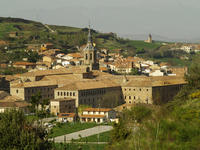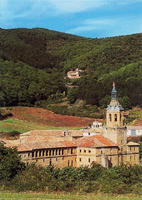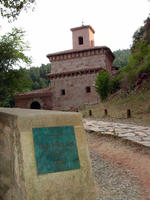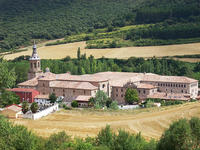You are in: Europe -> Spain -> San Millán Yuso and... , and traditional search or Image Gallery will yield results of this site only
San Millán Yuso and Suso Monasteries
| Site number: | 805 |
|
| Type of site: | Cultural | |
| Date: | Mid-6th century | |
| Date of Inscription: | 1997 | |
| Location: | Europe, Spain, San Millán de la Cogolla, Province and Autonomous Community of La Rioja | |
Up to 75 images are shown here. Click on each for more details or on Image Gallery for more images.
| Description: | St Millán founded this monastic community in the mid-6th century, which has become a place of pilgrimage. At the site of Suso a fine Romanesque church that was erected in honour of the holy man still stands intact today. This site was where the earliest Castilian literature was produced; from it derives one of the world’s most commonly spoken languages. The fine new monastery of Yuso accommodated the community in the early 16th century, right underneath the older complex; it has remained a thriving community to this day. --WHMNet paraphrase from the description at WHC Site, where additional information is available. | |
| San Millán de la Cogolla is a sparsely populated municipality in La Rioja, (Spain). It takes its name from a 6th-century saint (Saint Emilianus or San Millán)) who lived here, and is famous for its twin monasteries, Yuso and Suso, which were declared a World Heritage Site in 1997. Suso is the older of the two monasteries, and it is the site where phrases in the Spanish and Basque languages were written for the first time - the codex in question was subsequently preserved in the monastery library at Yuso before being moved to its current location in Madrid. The phrases in Spanish are glosses on a Latin text and are known as the Glosas Emilianenses. There is some debate as to whether they are written in an early form of Castilian or in a related dialect. In either case, San Millán's importance as a cradle of the Spanish language is reinforced by the proximity of the village of Berceo which is associated with Gonzalo de Berceo, the first poet in the Spanish language. There is a continuous history of Christianity at San Millán since the time of the saint. The scriptorium remained active during the period of Muslim rule; and over the centuries, the religious community has overcome various vicissitudes which affected the monasteries (for example being sacked by the Black Prince). However the type of monastic life has evolved - the original monks living at Suso were hermits, but Yuso developed as a Benedictine community and is now Augustinian. As the UNESCO evaluation noted, San Millán shows the transformation from an eremetic to a cenobitic community in material terms. Today San Millán attracts pilgrims on the Way of St James (although it lies somewhat off the line of the official route between Nájera and Burgos). Part of Yuso monastery has been converted into a hotel. Jews were living here as early as at Nájera, and they suffered greatly in the civil war between Pedro of Castile and Henry II of Castile. On Oct. 15, 1369, at the request of the directors of the small aljama of San Millán, whose cause was advocated by "certain Jews who were received at court," Henry II of Castile ordered that "the Christian men and women and the Moorish men and women" should immediately discharge all their debts to the Jews, "that the last-named might be able to pay their taxes the more promptly." On Sept. 10, 1371, however, the king released the abbot and all the monks of San Millán from whatever debts they had contracted with the Jews since the Battle of Nájera (Navarrete). --Wikipedia. Text is available under the Creative Commons Attribution-ShareAlike License. | ||
| Source: | http://whc.unesco.org/en/list/805 | |
| Reference: | 1. UNESCO World Heritage Center, Site Page. | |
















